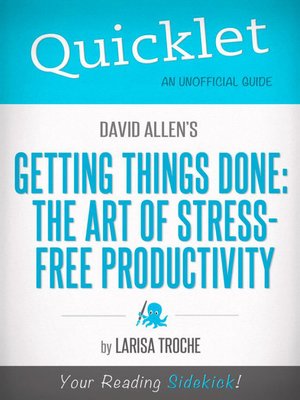Quicklet on David Allen's Getting Things Done
ebook ∣ Cliffnotes-like Book Summary and Analysis
By Larisa Troche

Sign up to save your library
With an OverDrive account, you can save your favorite libraries for at-a-glance information about availability. Find out more about OverDrive accounts.
Find this title in Libby, the library reading app by OverDrive.



Search for a digital library with this title
Title found at these libraries:
| Library Name | Distance |
|---|---|
| Loading... |
ABOUT THE BOOK
I think entrepreneurs, because of their high level of achievement and drive, are constantly looking at ways to do things faster, better, smarter; I am no exception. As an overly busy businesswoman, I was drawn to the title of the book, as I was looking for productivity tools that I would actually use on a regular basis.In the hopes that the pages contained a magic wand, I quickly scanned through them for the one tip that I could immediately use—something that would make a dent in my workload. I was also very drawn to the concept of having a quiet, clutter-free mind. What I liked about David Allen's "Getting Things Done: The Art of stress-Free Productivity" was that there wasa certain simplicity to his suggestions for getting organized.
MEET THE AUTHOR
Ms. Larisa Troche is a multi-preneur as founder and CEO of her company The Larisa Group which provides professional management and consulting services for small business and real estate. She is also the founder of Pink Passport Society, Inc. the premier worldwide "insider's club" for women creating wealth through community and connections. Larisa holds a California Real Estate Broker's license, a Masters in Business Administration, and a Bachelor's degree in Human Relations Management.
EXCERPT FROM THE BOOK
Next, in Part II, Practicing Stress-free Productivity, the whole systemunfolds and it's finally time to begin, starting with preparing the time, space and tools for implementing the techniques.Extra attention needs to be paid to correctly setting up your filing system, which should include a General Reference File (emails, brochures, notes, etc. that you want to retain for future use); using one alphabetic filing system (not multiple iterations for different projects).Start with all the physical things that aren't where they should be. Ideally you'll want to try and put everything into your in-basket (literally). Once you've collected all the "things" it is time to empty your brain and make a list of every single thing, every mental to-do, on a separate sheet of paper—not one long list. Emptying your brain includes writing your voicemails down and putting them in the inbox as well as your day planner if you use one.Buy a copy to continue reading!







